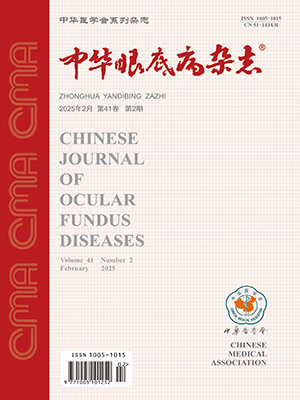| 1. |
Kaye R, Chandra S, Sheth J, et al. Central serous chorioretinopathy: an update on risk factors, pathophysiology and imaging modalities[J/OL]. Prog Retin Eye Res, 2020, 79: 100865[2020-05-11]. https://pubmed.ncbi.nlm.nih.gov/32407978/. DOI: 10.1016/j.preteyeres.2020.100865.
|
| 2. |
Spaide RF, Gemmy Cheung CM, Matsumoto H, et al. Venous overload choroidopathy: a hypothetical framework for central serous chorioretinopathy and allied disorders[J/OL]. Prog Retin Eye Res, 2022, 86: 100973[2021-05-21]. https://pubmed.ncbi.nlm.nih.gov/34029721/. DOI: 10.1016/j.preteyeres.2021.100973.
|
| 3. |
Hiroe T, Kishi S. Dilatation of asymmetric vortex vein in central serous chorioretinopathy[J]. Ophthalmol Retina, 2018, 2(2): 152-161. DOI: 10.1016/j.oret.2017.05.013.
|
| 4. |
Bacci T, Oh DJ, Singer M, et al. Ultra-widefield indocyanine green angiography reveals patterns of choroidal venous insufficiency influencing pachychoroid disease[J]. Invest Ophthalmol Vis Sci, 2022, 63(1): 17. DOI: 10.1167/iovs.63.1.17.
|
| 5. |
Ramtohul P, Cabral D, Oh D, et al. En face ultrawidefield OCT of the vortex vein system in central serous chorioretinopathy[J]. Ophthalmol Retina, 2023, 7(4): 346-353. DOI: 10.1016/j.oret.2022.10.001.
|
| 6. |
Hoshino J, Matsumoto H, Mukai R, et al. Variation of vortex veins at the horizontal watershed in normal eyes[J]. Graefe's Arch Clin Exp Ophthalmol, 2021, 259(8): 2175-2180. DOI: 10.1007/s00417-021-05130-2.
|
| 7. |
Pauleikhoff L, Agostini H, Lange C. Central serous chorioretinopathy[J]. Ophthalmologe, 2021, 118(9): 967-980. DOI: 10.1007/s00347-021-01376-7.
|
| 8. |
Jung JJ, Yu DJG, Ito K, et al. Quantitative assessment of asymmetric choroidal outflow in pachychoroid eyes on ultra-widefield indocyanine green angiography[J]. Invest Ophthalmol Vis Sci, 2020, 61(8): 50. DOI: 10.1167/iovs.61.8.50.
|
| 9. |
Hoseini-Yazdi H, Vincent SJ, Collins MJ, et al. Wide-field choroidal thickness in myopes and emmetropes[J/OL]. Sci Rep, 2019, 9(1): 3474[2019-03-05]. https://pubmed.ncbi.nlm.nih.gov/30837507/. DOI: 10.1038/s41598-019-39653-w.
|
| 10. |
Daruich A, Matet A, Dirani A, et al. Central serous chorioretinopathy: recent findings and new physiopathology hypothesis[J]. Prog Retin Eye Res, 2015, 48: 82-118. DOI: 10.1016/j.preteyeres.2015.05.003.
|
| 11. |
Guyer DR, Yannuzzi LA, Slakter JS, et al. Digital indocyanine green videoangiography of central serous chorioretinopathy[J]. Arch Ophthalmol, 1994, 112(8): 1057-1062. DOI: 10.1001/archopht.1994.01090200063023.
|
| 12. |
Iida T, Kishi S, Hagimura N, et al. Persistent and bilateral choroidal vascular abnormalities in central serous chorioretinopathy[J]. Retina, 1999, 19(6): 508-512. DOI: 10.1097/00006982-199911000-00005.
|
| 13. |
Imamura Y, Fujiwara T, Margolis R, et al. Enhanced depth imaging optical coherence tomography of the choroid in central serous chorioretinopathy[J]. Retina, 2009, 29(10): 1469-1473. DOI: 10.1097/IAE.0b013e3181be0a83.
|
| 14. |
Ishikura M, Muraoka Y, Nishigori N, et al. Widefield choroidal thickness of eyes with central serous chorioretinopathy examined by swept-source OCT[J]. Ophthalmol Retina, 2022, 6(10): 949-956. DOI: 10.1016/j.oret.2022.04.011.
|
| 15. |
Mori K, Gehlbach PL, Yoneya S, et al. Asymmetry of choroidal venous vascular patterns in the human eye[J]. Ophthalmology, 2004, 111(3): 507-512. DOI: 10.1016/j.ophtha.2003.06.009.
|
| 16. |
Ikuno Y, Kawaguchi K, Nouchi T, et al. Choroidal thickness in healthy Japanese subjects[J]. Invest Ophthalmol Vis Sci, 2010, 51(4): 2173-2176. DOI: 10.1167/iovs.09-4383.
|
| 17. |
Mihara N, Sonoda S, Terasaki H, et al. Sex- and age-dependent wide-field choroidal thickness differences in healthy eyes[J]. J Clin Med, 2023, 12(4): 1505. DOI: 10.3390/jcm12041505.
|
| 18. |
Yang L, Jonas JB, Wei W. Choroidal vessel diameter in central serous chorioretinopathy[J/OL]. Acta Ophthalmol, 2013, 91(5): e358-e362[2013-05-07]. https://pubmed.ncbi.nlm.nih.gov/23647989/. DOI: 10.1111/aos.12059.
|




